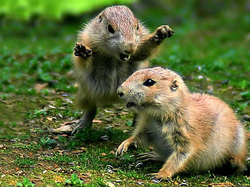
Tom Parker, a biology professor, has arrived at an unusual discovery. In the California shrubland and forests that burned up in 2008, Parker found Manzanita seedlings growing in dense clusters, indicating that the shrubs sprouted from underground seeds.
Every year, wildfires present Parker with new proof about how the native plants of California deal with extreme temperature. The professor currently spends evenings in the field, tracking down meadow voles, kangaroo rats and mice, which he thinks are stashing away seeds of Manzanita and helping the plants cope with fire conditions.
“We believe that rodents open up Manzanita's cherry-like fruit and bury the seeds found inside, similar to a squirrel hiding its nuts to eat later”, stated Parker, who specialises on Manzanita, a cluster of evergreen shrubs and trees. “What's critical is that they bury the seeds at a depth that the seeds can survive the heat if a fire breaks out”.
His experiments attract the rodents to containers of fruit and trace their footprints by means of fluorescent powder that is seen under with UV light. “We want to get the rodents to bury the seeds so we can see how many they are burying in one cache and how deep they are burying them”, said Parker.
He plans to imitate the distribution and depth of the seedlings in laboratory experiments to prove whether the stashes of rodents enhance the seeds’ survival rates.
“Sometimes plants develop survival strategies that use the help of animals, like bees pollinating flowers”, he explained. “If our hypothesis is correct, we'll show that contrary to popular belief, rodents are more of a help than a hindrance to Manzanita”.
Every year, wildfires present Parker with new proof about how the native plants of California deal with extreme temperature. The professor currently spends evenings in the field, tracking down meadow voles, kangaroo rats and mice, which he thinks are stashing away seeds of Manzanita and helping the plants cope with fire conditions.
“We believe that rodents open up Manzanita's cherry-like fruit and bury the seeds found inside, similar to a squirrel hiding its nuts to eat later”, stated Parker, who specialises on Manzanita, a cluster of evergreen shrubs and trees. “What's critical is that they bury the seeds at a depth that the seeds can survive the heat if a fire breaks out”.
His experiments attract the rodents to containers of fruit and trace their footprints by means of fluorescent powder that is seen under with UV light. “We want to get the rodents to bury the seeds so we can see how many they are burying in one cache and how deep they are burying them”, said Parker.
He plans to imitate the distribution and depth of the seedlings in laboratory experiments to prove whether the stashes of rodents enhance the seeds’ survival rates.
“Sometimes plants develop survival strategies that use the help of animals, like bees pollinating flowers”, he explained. “If our hypothesis is correct, we'll show that contrary to popular belief, rodents are more of a help than a hindrance to Manzanita”.
 RSS Feed
RSS Feed